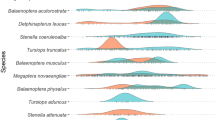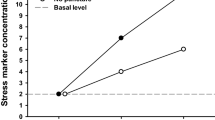Abstract
For over 40 years, biopsy darting has been increasingly used to obtain DNA and other samples from cetaceans; however, its application to other species is more recent. We assessed the performance of helicopter-based biopsy darting of polar bears (Ursus maritimus) on the spring sea ice. Our aim was to provide an overview and evaluation of our protocols for others considering helicopter-based biopsy darting. We shot 55 biopsy darts at 46 polar bears. Most darts (n = 51; 93%) hit the bear, but four of these were likely glancing shots that did not collect a biopsy sample. Mean chase time by the helicopter was short (\(\overline x\) = 23 s; range = 8–60 s), but chase time was significantly greater for bears with cubs than those without. There was no significant difference in chase time between bears that ran from the helicopter and those that charged it, but missed shots occurred more frequently for bears initially charging the aircraft, necessitating a second shot. We observed minor reactions (flinching or glancing backward) by 24% of the bears to the dart itself; however, all bears had a flight or fight response to the helicopter. All but one dart was retrieved. The dart success rate—the percentage of darts that hit the bear and collected a tissue (skin) sample—was 88%. However, only 53% collected more than a minimal amount of fat. All of the skin samples collected yielded DNA. Our study, along with the experiences of others, demonstrates that biopsy darting of polar bears has potential for genetic tagging of individuals for capture-mark-recapture studies. While we provide further information on equipment, protocols, and performance of helicopter-based biopsy darting, work remains to improve equipment and protocols, and better assess the impacts to affected individuals. We encourage further research on biopsy darting terrestrial mammals to spur technological advancements and guide the development of best practices.




Similar content being viewed by others
References
Aars J, Marques TA, Lone K, Andersen M, Wiig Ø, Fløystad IM, Hagen SB, Buckland ST (2017) The number and distribution of polar bears in the western Barents Sea area. Polar Res 36:1374125
Amstrup SC, McDonald TL, Stirling I (2001) Polar bears inthe Beaufort Sea: a 30-year mark-recapture case history. J Agric Biol EnvironStat 6:221
Anderson CJR, Lobo NDV, Roth JD, Waterman JM (2010) Computer-aided photo-identification system with an application to polar bears based on whisker spot patterns. J Mammal 91:1350–1359
Atkinson S, Laidre K, Arnold T, Stapleton S, Regehr E, BornE Wiig Ø, Dyck M, Lunn N, Stern H, Paetkau D (2021) A novelmark-recapture-recovery survey using genetic sampling for polar bears Ursus maritimus in Baffin Bay. Endanger Species Res 46:105–120
Bromaghin JF, McDonald TL, Stirling I, Derocher AE, Richardson ES, Regehr EV, Douglas DC, Durner GM, Atwood T, Amstrup SC (2015) Polar bear population dynamics in the southern Beaufort Sea during a period of sea ice decline. Ecol Appl 25:634–651
Beausoleil RA, Clark JD, Maletzke BT (2016) A long-termevaluation of biopsy darts and DNA to estimate cougar density: anagency-citizen science collaboration. Wildl Soc Bull 40:583–592
Cattet MRL, Bourque A, Elkin BT, Powley KD, Dahlstrom DB, Caulkett NA (2006) Evaluation of the potential for injury with remote drug-delivery systems. Wildl Soc Bull 34:741–749
de Groot PvC, Wong PBY, Harris C, Dyck MG, Kamookak L, Pagès M, Michaux J, Boag PT, (2013) Toward a non-invasive Inuit polar bear survey: genetic data from polar bear hair snags. Wildl Soc Bull 37:394–401
Derocher AE, Aars J, Amstrup SC, Cutting A, Lunn NJ, Molnár PK, Obbard ME, Stirling I, Thiemann GW, Vongraven D, Wiig Ø, York G (2013) Rapid ecosystem change and polar bear conservation. Conserv Lett 6:368–375
Dubach JM, Briggs MB, White PA, Ament BA, Patterson BD (2013) Genetic perspectives on “lion conservation units” in eastern and southern Africa. Conserv Genet 14:741–755
Dyck M (2016) Estimating the abundance of the M’Clintock Channel polar bear sub-population by genetic mark-recapture. Unpublished report for the Government of Nunavut, Igloolik, Nunavut, Canada
Galicia MP, Thiemann GW, Dyck MG, Ferguson SH (2021) Are tissue samples obtained via remote biopsy useful for fatty acid-based diet analyses in a free-ranging carnivore? J Mammal 102:1067–1078
Harms NJ, Jung TS, Hallock M, Egli K (2018) Efficacy of a butorphanol, azaperone, and medetomidine combination for helicopter-based immobilization of bison (Bison bison). J Wildl Dis 54:819–824
Hegel TM, Russel K, Jung TS (2012) Using temporary dye marks to estimate ungulate population abundance in southwest Yukon, Canada. Rangifer Spec Issue 20:219–226
Herreman J, Peacock E (2013) Polar bear use of a persistent food subsidy: insights from non-invasive genetic sampling in Alaska. Ursus 24:148–163
Jacques CN, Jenks JA, Deperno CS, Sievers JD, Grovenburg TW, Brinkman TJ, Swanson CC, Stillings BA (2009) Evaluating ungulate mortality associated with helicopter net-gun captures in the northern Great Plains. J Wildl Manage 73:1282–1291
Jung TS, Boonstra R, Krebs CJ (2020) Mark my words: experts’ choice of marking methods used in capture-mark-recapture studies of small mammals. J Mammal 101:307–317
Jung TS, Konkolics SM, Kukka PM, Majchrzak YN, Menzies AK, Oakley MP, Peers MJL, Studd EK (2019) Short-term effect of helicopter-based capture on movements of a social ungulate. J Wildl Manage 83:830–837
Jung TS, Hegel TM, Bentzen TW, Egli K, Jessup L, Kienzler M, Kuba K, Kukka PM, Russell K, Suitor M, Tatsumi K (2018) Accuracy and performance of low-feature GPS collars deployed on bison Bison bison and caribou Rangifer tarandus. Wildl Biol 2018:wlb.00404
Karanth KU, Nichols JD, Kumar NS, Hines JE (2006) Assessing tiger population dynamics using photographic capture-recapture sampling. Ecology 87:2925–2937
Latham ADM, Davidson B, Warburton B, Yockney I, Hampton JO (2020) Efficacy and animal welfare impacts of novel capture methods for two species of invasive wild mammals in New Zealand. Animals 10:44
Lillie KM, Gese EM, Attwood TC, Conner MM (2019) Use of subsistence-harvested whale carcasses by polar bears in the southern Beaufort Sea. Arctic 72:404–412
Malenfant RM, Coltman DW, Richardson ES, Lunn NJ, Stirling I, Adamowicz E, Davis CS (2016) Evidence of adoption, monozygotic twinning, and low inbreeding rates in a large genetic pedigree of polar bears. Polar Biol 39:1455–1465
McMahon CR, Hindell MA, Harcourt RG (2012) Publish or perish: why it’s important to publicise how, and if, research activities affect animals. Wildl Res 39:375–377
Mijele D, Omondi P, Gakuya F, Rossi L, Chiyo PI, Soriguer RC, Angelone-Alasaad S (2016) A practical guideline to remote biopsy darting of wildebeests for genetic sampling. Inter J Vet Sci Med 4:27–32
Mowat G, Strobeck C (2000) Estimating population size of grizzly bears using hair capture, DNA profiling, and mark-recapture analysis. J Wildl Manage 64:83–193
Mulders R, Boulanger R, Paetkau D (2007) Estimation of population size for wolverines Gulo gulo at Daring Lake, Northwest Territories, using DNA based mark-recapture methods. Wildl Biol 13:38–51
Noren DP, Mocklin JA (2012) Review of cetacean biopsy techniques: factors contributing to successful sample collection and physiological and behavioral impacts. Mar Mamm Sci 28:154–199
Obbard ME, Stapleton S, Szor G, Middel KR, Jutras C, Dyck M (2018) Re-assessing abundance of Southern Hudson Bay polar bears by aerial survey: effects of climate change at the southern edge of the range. Arctic Sci 4:634–655
Olson TL (2009) Remote biopsy dart sampling of brown bears. National Park Service, Alaska Region Natural Resources Technical Report NPS/AR/NRTR-2009–74
Pagano AM, Peacock E, McKinney MA (2014) Remote biopsy darting and marking of polar bears. Mar Mamm Sci 30:169–183
Paetkau D (2003) An empirical exploration of data quality in DNA-based population inventories. Mol Ecol 12:1375–1387
Paetkau D, Amstrup SC, Born EW, Calvert W, Derocher AE, Garner GW, Messier F, Stirling I, Taylor MK, Wiig Ø, Strobeck C (1999) Genetic structure of the world’s polar bear populations. Mol Ecol 8:1571–1584
Peacock E, Derocher AE, Thiemann GW, Stirling I (2011) Conservation and management of Canada’s polar bears (Ursus maritimus) in a changing Arctic. Can J Zool 89:371–385
Poncelet É, Barbraud C, Guinet C (2010) Population dynamics of killer whales (Orcinus orca) in the Crozet Archipelago, southern Indian Ocean: a mark-recapture study from 1977 to 2002. J Cetacean Res Manage 11:41–48
Rode KD, Pagano AM, Bromaghin JF, Atwood TC, Durner GM, Simac KS, Amstrup SC (2014) Effects of capturing and collaring on polar bears: findings from long-term research on the southern Beaufort Sea population. Wildl Res 41:311–322
Roffler GH, Waite JN, Zarn KE, Schwartz MK (2019) Estimating abundance of a cryptic social carnivore using spatially explicit capture-recapture. Wildl Soc Bull 43:31–41
Shivik JA, Ruid D, Willging RC, Mock KE (2011) Are the same bears repeatedly translocated from corn crops in Wisconsin? Ursus 22:114–119
Stapleton S, Atkinson S, Hedman D, Garshelis D (2014) Revisiting Western Hudson Bay: using aerial surveys to update polar bear abundance in a sentinel population. Biol Conserv 170:38–47
Stirling I, McDonald TL, Richardson ES, Regehr EV, AmstrupSC, (2011) Polar bear population status in the northern Beaufort Sea, Canada, 1971–2006. Ecol Appl 21:859–876
Thiemann GW, Iverson SJ, Stirling I (2006) Seasonal, sexual and anatomical variability in the adipose tissue of polar bears (Ursus maritimus). J Zool 269:65–76
Vongraven D, Aars J, Amstrup S, Atkinson SN, Belikov S, Born EW, DeBruyn TW, Derocher AE, Durner G, Gill M, Lunn N, Obbard ME, Omelak J, Ovsyanikov N, Peacock E, Richardson E, Sahanatien V, Stirling I, Wigg Ø (2012) A circumpolar monitoring framework for polar bears. Ursus 23:1–66
Acknowledgements
We are grateful to the Inuvialuit-Inupiat Polar Bear Joint Commission for encouraging this study in the Inuvialuit Settlement Region, as well as providing advice and feedback on the design and results of our work, particularly J Lucas Jr., DC Gordon, and E Pokiak. L Emaghok, D Gordon Jr, and J Nuyaviak are thanked for participating in our darting operations and teaching us about polar bears. We are indebted to M Dyck and S Atkinson for providing us with much-needed guidance on darting polar bears at the outset of our project. We also thank T Atwood, N Lunn, R Mulders, J Pisapio, G Szor, and J Ware for sharing their experiences biopsy darting polar bears. C Lennie, B Healy, and Z Gyorfi are thanked for safe piloting of their helicopters. J Hampton, four anonymous reviewers, and the handling editor kindly provided comments that improved our manuscript.
Funding
Support for this work was provided by the Inuvialuit Game Council, Wildlife Management Advisory Council (NWT), Wildlife Management Advisory Council (North Slope), Aklavik Hunters and Trappers Committee, Tuktoyaktuk Hunters and Trappers Committee, Government of Yukon, and Government of Northwest Territories.
Author information
Authors and Affiliations
Contributions
TSJ conceived the study, collected and analyzed the data, wrote the first draft, and managed revisions. MJS and SB collected the data, contributed to the first draft, and secured funding.
Corresponding author
Ethics declarations
Conflict of interest
The authors declare no competing interests.
Additional information
This paper is dedicated to the memory of pilot Chris Lennie (deceased), whom we had the privilege of doing this work with. Working with polar bears in his Indigenous settlement lands was a dream of his come true.
Publisher's Note
Springer Nature remains neutral with regard to jurisdictional claims in published maps and institutional affiliations.
Rights and permissions
About this article
Cite this article
Jung, T.S., Suitor, M.J. & Baryluk, S. Performance of helicopter-based biopsy darting of polar bears (Ursus maritimus) on the spring sea ice. Eur J Wildl Res 67, 106 (2021). https://doi.org/10.1007/s10344-021-01550-x
Received:
Revised:
Accepted:
Published:
DOI: https://doi.org/10.1007/s10344-021-01550-x




